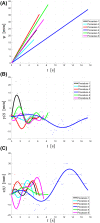Needle path planning in semiautonomous and teleoperated robot-assisted epidural anaesthesia procedure: A proof of concept
- PMID: 35699156
- PMCID: PMC9787351
- DOI: 10.1002/rcs.2434
Needle path planning in semiautonomous and teleoperated robot-assisted epidural anaesthesia procedure: A proof of concept
Abstract
Background: Epidural anaesthesia is a Percutaneous Procedure (PP) which plays a crucial role in surgical procedures, where accurate needle insertion is still challenging. The objective of this work is to present a Tuohy needle path planning, which allows an anaesthesiologist to drive semiautonomously, with the assistance of a teleoperated robot, the tip of the needle during this PP.
Methods: We capture, analysed and modelled the anaesthetist hands' motion during the execution of this procedure, by synthetising, programing and simulating a parametrised and normalised kinematic constrains dependent on an insertion variable in a virtual robot.
Results: Two preoperative path planning models were obtained, which provide a teleoperated robot with kinematic constraints to semiautonomously drive a Tuohy needle in the epidural anaesthesia procedure.
Conclusions: A semiautonomous robot can assist in the execution of this PP using the kinematic constraints obtained from the study of the movement of a specialist's hands.
Keywords: epidural anaesthesia procedure; needle path planning; percutaneous procedure; semiautonomous robot.
© 2022 The Authors. The International Journal of Medical Robotics and Computer Assisted Surgery published by John Wiley & Sons Ltd.
Conflict of interest statement
The authors have no conflicts of interest to declare that are relevant to the content of this article.
Figures








Similar articles
-
Human-robot collaborated path planning for bevel-tip needle steering in simulated human environment.Annu Int Conf IEEE Eng Med Biol Soc. 2016 Aug;2016:5672-5675. doi: 10.1109/EMBC.2016.7592014. Annu Int Conf IEEE Eng Med Biol Soc. 2016. PMID: 28269542
-
Path planning for robot-assisted active flexible needle using improved Rapidly-Exploring Random trees.Annu Int Conf IEEE Eng Med Biol Soc. 2014;2014:380-3. doi: 10.1109/EMBC.2014.6943608. Annu Int Conf IEEE Eng Med Biol Soc. 2014. PMID: 25569976
-
Towards a realistic in vitro experience of epidural Tuohy needle insertion.Proc Inst Mech Eng H. 2013 Jul;227(7):767-77. doi: 10.1177/0954411913483428. Epub 2013 Apr 4. Proc Inst Mech Eng H. 2013. PMID: 23636758
-
The Adaptive Hermite Fractal Tree (AHFT): a novel surgical 3D path planning approach with curvature and heading constraints.Int J Comput Assist Radiol Surg. 2019 Apr;14(4):659-670. doi: 10.1007/s11548-019-01923-3. Epub 2019 Feb 21. Int J Comput Assist Radiol Surg. 2019. PMID: 30790172 Free PMC article. Review.
-
Zerobot®: A Remote-controlled Robot for Needle Insertion in CT-guided Interventional Radiology Developed at Okayama University.Acta Med Okayama. 2018 Dec;72(6):539-546. doi: 10.18926/AMO/56370. Acta Med Okayama. 2018. PMID: 30573907 Review.
Cited by
-
Decision-making in anesthesiology: will artificial intelligence make intraoperative care safer?Curr Opin Anaesthesiol. 2023 Dec 1;36(6):691-697. doi: 10.1097/ACO.0000000000001318. Epub 2023 Oct 13. Curr Opin Anaesthesiol. 2023. PMID: 37865848 Free PMC article. Review.
References
-
- Abolhassani N, Patel R, Moallem M. Needle insertion into soft tissue: a survey. Med Eng Phys. 2007;29(4):413‐431. - PubMed
-
- Kang H, Wen JT. Autonomous suturing using minimally invasive surgical robots. In: Proceedings of the 2000 IEEE International Conference on Control Applications. Conference Proceedings (Cat. No.00CH37162). IEEE; 2000:742‐747.
-
- Chow D‐L, Newman W. Improved knot‐tying methods for autonomous robot surgery. In: 2013 IEEE International Conference on Automation Science and Engineering (CASE). IEEE; 2013:461‐465.
-
- Ye M, Li W, Chan DTM, Chiu PWY, Li Z. A semi‐autonomous stereotactic brain biopsy robot with enhanced safety. IEEE Rob Autom Lett. 2020;5(2):1405‐1412.
MeSH terms
Grants and funding
LinkOut - more resources
Full Text Sources
Miscellaneous

